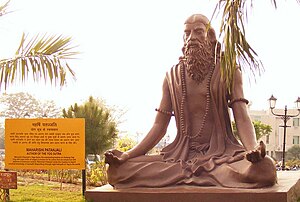Note: This is a project under development. The articles on this wiki are just being initiated and broadly incomplete. You can Help creating new pages.
Difference between revisions of "Yoga Sutras of Patanjali"
Chaithrika (talk | contribs) (Created page with "thumb|right|''' Patanjali'''] The Yoga Sūtras of Patañjali are 196 Indian sutras (aphorisms). The Yoga Sutras were compiled prior to 400 CE b...") |
(No difference)
|
Revision as of 16:35, 21 April 2017
]
The Yoga Sūtras of Patañjali are 196 Indian sutras (aphorisms). The Yoga Sutras were compiled prior to 400 CE by Sage Patanjali, taking materials about yoga from older traditions. The Yoga Sūtras of Patañjali was the most translated ancient Indian text in the medieval era, having been translated into about forty Indian languages and two non-Indian languages: Old Javanese and Arabic. The text fell into obscurity for nearly 700 years from the 12th to 19th century, and made a comeback in late 19th century due to the efforts of Swami Vivekananda, the Theosophical Society and others. It gained prominence again as a comeback classic in the 20th century.
Contents
About
The Yoga Sūtras text is attributed to Patanjali. Much confusion surrounds this Patañjali, because an author of the same name is credited to be the author of the classic text on Sanskrit grammar named Mahābhāṣya. Yet the two works in Sanskrit are completely different in subject matter. Furthermore, before the time of Bhoja (11th century), no known text states that the authors were the same.
Period
Philipp A. Maas assesses Patañjali's Yogasutra's date to be about 400 CE, based on tracing the commentaries on it published in the first millennium CE, and a review of extant literature.
Edwin Bryant, on the other hand, surveys the major commentators in his translation of the Yoga Sūtras. He observes that "Most scholars date the text shortly after the turn of the Common Era (circa first to second century), but that it has been placed as early as several centuries before that." Bryant concludes that "A number of scholars have dated the Yoga Sūtras as late as the fourth or fifth century C.E., but these arguments have all been challenged. ... All such arguments [for a late date] are problematic."
Michele Desmarais summarizes a wide variety of dates assigned to Yogasutra, ranging from 500 BCE to 3rd century CE, noting that there is a paucity of evidence for any certainty. She states the text may have been composed at an earlier date given conflicting theories on how to date it, but latter dates are more commonly accepted by scholars.
Chapters
- Samadhi Pada
- Samadhi Pada
- Vibhuti Pada
- Kaivalya Pada
